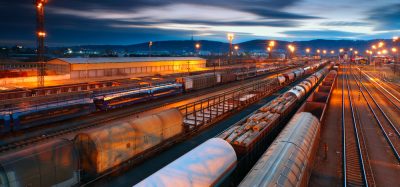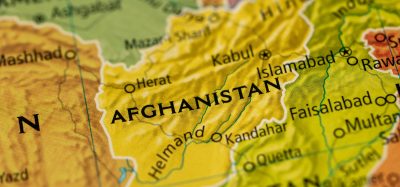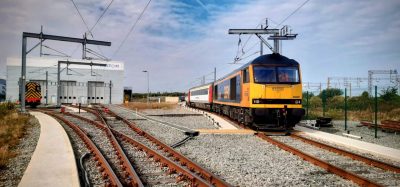The campaign for freight on rail: exploiting rail freight’s potential
Posted: 21 July 2009 | | No comments yet
Philippa Edmunds, freight on rail campaigner, argues the case for freight on rail and how it can help the UK meet its own legally binding climate change emissions targets.
Philippa Edmunds, freight on rail campaigner, argues the case for freight on rail and how it can help the UK meet its own legally binding climate change emissions targets.
Rail freight is a win/win for the economy, environment and society which can help the Government to build a low carbon economy. If the UK is to meet its own legally binding climate change emissions targets, it needs to fully exploit rail freight’s potential to help build a low carbon economy. Rail freight, favoured by the general public, is a low carbon energy-efficient safer mode of freight transport which reduces road congestion. The simple statistic which shows that an average freight train can remove 50 HGVs from our roads1, clearly illustrates what rail freight contributes to our economy and society.
Why rail freight?
The reality is if the country is to achieve the 80% reduction in carbon dioxide emissions the Government has committed itself to, by 2050, freight emissions have to be controlled; rail, which produces between three to five times less carbon dioxide than road, per tonne carried, can help achieve this. Energy efficiency is directly related to carbon dioxide emissions; rail is far more energy efficient than road and air transport which makes rail an attractive option with price variations and unreliability of energy sources.
According to the Government’s own figures, road fatalities cost the Government £3 billion per annum. Overall, road accidents cost approximately £18 billion per annum according to DfT figures. Transferring freight to rail can significantly reduce road accidents because HGVs (because of their size and weight) are disproportionately more likely to be involved in fatal accidents – for example on motorways as HGVs are over three times more likely than cars to be involved in fatalities from road accidents per billion kms travelled2.
Rationale for Freight on Rail – setting the planning framework to promote rail freight
Members of Freight on Rail identified that helping central, local and regional Government to set the right planning framework is a key component of realising this shift to rail. So, Freight on Rail, a partnership between the rail freight industry, the transport trade unions and Campaign for Better Transport, was set up to lobby central, regional and local Government to get the right policies and strategies in place to facilitate rail freight.
National safeguarding of rail corridors and lands needed
As part of the Planning Act of November 2008, National Policy Statements (NPSs), which will create an over-arching national spatial planning framework, for the first time in the UK, represent an opportunity to integrate land-use planning and transport policy. Freight on Rail believes that the railways need to be given the same powers as the Highways Agency, which can scrutinise plans and applications to look at the impact on its network from surrounding development, so that potential rail corridors can be protected for future possible rail use and low carbon rail interchanges can be built, for example in the right places. There is a danger that if there is not a mechanism to protect land for rail corridors, then we will get safeguarded alignments for roads but not for rail. Essentially, the railways and Network Rail ought to be put on the same basis as the Highways Agency. Up until now, safeguarding has relied on local authorities but this does not allow a wider vision for the low carbon economy. For example, we want NPSs to state that any applications for regional distribution depots and factories should be capable of being rail connected to avoid the mistakes of the past where car factories and large distribution centres were allowed to locate without rail access.
Local and regional government shape the planning framework, within their borders, through Regional strategies and Local Development frameworks (LDFs) currently in the UK. So it is vital that regional and local spatial planning makes more detailed provision for rail freight in addition to the new national frameworks, i.e. NPSs, which by nature will be high level. It needs to identify and protect existing and disused sites, lines and sidings and suitable interchange locations. In particular, planning permission for rail interchanges, without which rail freight cannot increase, will not be secured unless the right policies are enshrined in the spatial planning framework. Without these policies, it can be difficult for local councillors to demonstrate the wider regional and national benefits of a rail freight terminal because of local disbenefits, such as increased HGV movements. Without planning permission for new interchanges, more freight cannot be removed from our congested road network.
The High Court case of Mansard County Homes v Surrey Heath of 2002 shows councils countrywide that, with Planning Policy Guidance PPG13, they can protect disused railway land for future potential railway use, without fear of litigation if this land is identified in local transport plans, even where there is no immediate evidence of future possible use.
Freight on Rail seeks to encourage and help councillors and officers engage with terminal operators, local business and the logistics industry as well as existing rail freight customers and Network Rail by acting as a facilitator within the industry. In addition to identifying what the major freight flows are, who the players are and what the rail infrastructure is, local and regional authorities can push for industrial development to be sited near railways, promote expansion in existing rail-connected sites and enter into partnerships with the rail freight industry to allow the commercial development of rail freight projects – for example, to part-fund connections, upgrades, terminals.
Government support for modal shift
Therefore, we warmly welcome the Government’s commitment of £200 million towards the Strategic Rail Freight Network (SFN) over the period 2009-2014 to provide a reliable robust strategic network with diversion routes which will connect national major freight routes including links to the ports – part of the plan to offer a 24/7 rail network.
This Government funding – to be used in conjunction with third party funding – is crucial, because it shows that it is committed to modal shift and emissions reductions, which then gives the industry the confidence to invest in the long-term. The lack of a level playing field between road and rail makes it difficult for rail freight to compete without Governmental support as road freight transport does not pay for all the costs3, it inflicts on society, such as in road accidents, road maintenance, health and congestion, which the taxpayer has to subsidise.
Industry forecasts shows that there is suppressed demand for rail in the UK because of existing limitations of the rail network and that rail freight can virtually double its surface market share from 11.2% to 20% by 2039.
The Government recognised the importance of upgrading key strategic links from the main container ports and undertook to contribute funding to increase the gauge clearance on key ports routes to at least W10 gauge, necessary because the international norm for intermodal containers is increasingly 9ft 6ins, which is too large for certain key rail routes using standard wagons. The following gauge and capacity schemes are benefitting from a combination of UK Government TIF, HLOS and SFN and third party funding.
Work to allow the larger containers and increase capacity on the key routes from the ports includes the key artery across London from Tilbury and London Gateway, linking the port of Liverpool to the main rail line. Gauge clearance and capacity upgrades on the routes from Southampton to the West Midlands are key national strategic projects to enhance the port links. The existing rail link which commands 23% of deep sea market, removes around a thousand lorries per day from the roads around Southampton and the A34.
Another top priority is the upgrading of the route from the Haven Ports directly to the East and West Midlands via Nuneaton and Leicester for container traffic from the ports with further onward connection to the North West and Scotland. This route will free up much needed freight capacity for the routes from Tilbury and London Thames Gateway as high gauge containers will no longer need to go via London when this route is finalised. Additional capacity work along this route from Felixstowe to Nuneaton, which could remove further lorry traffic from the congested parallel road route on the A14, is needed and is as yet unfunded. Rail has a 27% market share out of Felixstowe with 28 trains in and out per day, but with enhancements rail could command 25% of the market. Therefore, we are urging the Government to support this further capacity project in the next Network Rail control period starting in 2014 which would result in removing a massive 40 million lorry miles a year along the Felixstowe to Nuneaton corridor.
Government and industry partnerships needed to fund schemes
The Humber ports capacity upgrades have seen the re-opening of the Brigg Line in June 2008 and the Hull Docks branch completed in September 2008. The latter scheme, costing £15 million, was jointly funded by Yorkshire Forward, ABP and the Government which has resulted in an increase in capacity from 12 to 22 trains a day on the route. The gauge clearance from Southampton to the West Coast Main line on the route via Reading and Basingstoke, costing £70.7 million, has been secured with joint funding from Government, Seeda, ABP and EU. Synergy between passenger and freight upgrades means that the Reading station area enhancements will benefit freight which is travelling south to north from Southampton to the West Midlands, as well as those flows using the GWML going west to east. Other schemes being developed with direct freight and passenger benefits due for completion in December 2013 are the GN/GE Joint Line upgrade which can remove two million lorry miles per annum by providing diversionary capability for freight between Peterborough and Doncaster and the Shaftholme jnc Grade Separation which enables coal flows to avoid the ECML.
International rail freight
A European-gauge freight link which will allow full-size European rail freight vehicles to move between the UK and the rest of Europe, will open up a massive market for cross Channel rail freight. The first step has been secured as far as Barking as part of the SFN funding which aims to study a Channel tunnel route (CT3) to go via Redhill, Reading and beyond.
Train lengthening
The Government is committed to optimising rail network utilisation and therefore states that intermodal train lengths should be increased to 775m and, where feasible, greater lengths adopted for bulk trains. While road and rail modes complement each other, trunk movements of large quantities of freight can be more sustainably and more safely carried by rail than in even larger lorries so we welcome the commitment to longer and heavier trains rather than mega trucks.
The threat of mega trucks from Europe
Even though the UK Government recognised that mega trucks4 are not suitable for the UK, as they would lead to more pollution and exposure to road accidents as well as undermining rail, the European Commission continues to sponsor flawed research which recommends allowing cross border mega truck traffic which means mega trucks would come to the UK by default over time because of pressure from the road lobby.
The proponents’ case for mega trucks is predicated on mega trucks delivering a significant reduction in vehicle kilometres, proved by Freight on Rail to be incorrectly calculated. This inaccurate research seriously exaggerates the case for mega trucks. This basic error undermines the case for mega trucks as the justification for mega trucks, which the consultants themselves state are individually more dangerous than a standard HGV, relies on a significant reduction in lorry miles, which we have exposed as unfounded. The assumptions for safety and environmental improvement depend entirely on the prediction of a dramatic reduction in vehicle kilometres which are derived from incorrect calculations, as we have proved. Surprisingly, the increased costs of road accidents from mega trucks, which would have additional dangers of their own due to their size and lack of manoeuvrability, have not been included in this research. Transport Research Laboratories (TRL) highlighted serious stability problems at cruising speeds with double articulation, which can result in dangerously snaking, which the EC report does not address.
What also has to be taken into account is that the road haulage industry has a poor record in complying with existing road regulations which puts other road users at extra risk. For example, UK Government statistics show that over 82% of HGVs exceeded their speed limit of 50mph on dual carriageways in 2007 and VOSA spot checks in October 2008 found that half of UK registered HGVs stopped were breaking the law5. The promoters are claiming that mega trucks would be restricted to motorways, dual carriageways and major roads, but there is no mechanism available to keep them to this and the reality is that these vehicles will need local access to distribution hubs off motorways and dual carriageways.
Therefore, Freight on Rail is opposing these EC sponsored recommendations, based on unsound methodology, to allow cross border mega trucks traffic which would destroy the majority of rail freight which has a much better environmental and safety record than road and force trainloads of freight back onto our congested roads.
Freight on Rail urges the Government to continue support for SFN from 2014 onwards to carry on developing the low carbon freight network so that the industry has the confidence to carry on investing in the industry. Electrification of the Midland Main Line and the Great Western Lines, being considered by the Government, could open up new opportunities for rail freight along these corridors and from the European continent as long as gauge enhancements to W12 are included in the schemes.
There has been a sea-change in governmental and public perceptions of the need to reduce carbon dioxide emissions and that is why rail, as a low carbon energy efficient means of freight distribution, is so important in the context of creating long-term sustainable transport for society.
For further details on any of these issues, please go to www.freightonrail.org.uk.
References
- How we’re Measuring Up: our statement on social and environmental issues Railtrack 1999
- Sources for Tables 2 & 3: TSGB 2007, Goods Vehicle Statistics 2007, Goods Vehicle Accidents and Casualties 2007, all DfT
- Campaign for Better Transport research May 2008 shows that road freight only pays between one to two thirds of the of the damage they inflict on other road users and society. Taxpayers are subsidising lorries on Britain’s roads. The research, ‘Heavy Lorries: do they pay for the damage they cause?’ was produced by MTRU and peer-reviewed by Dr. Tony Whiteing, Institute for Transport Studies, University of Leeds.
- Mega trucks at 25 metres length 60 tonnes in weight would be fifty per cent longer and a third heavier than existing HGVs. UK Government rejected trials of mega trucks in June 2008.
- International Freighting Weekly; 21st October 2008
OUT NOW: The Definitive Guide to Rail’s Digital Future
The rail industry is undergoing a digital revolution, and you need to be ready. We have released our latest market report, “Track Insight: Digitalisation.”
This is not just another report; it’s your comprehensive guide to understanding and leveraging the profound technological shifts reshaping our industry. We move beyond the buzzwords to show you the tangible realities of AI, IoT, and advanced data analytics in rail.
Discover how to:
- Optimise operations and maintenance with real-time insights.
- Enhance passenger services through seamless, high-speed connectivity.
- Leverage technologies like LEO satellites to improve safety and efficiency.
Featuring expert analysis from leaders at Nomad Digital, Lucchini RS, Bentley Systems and more, this is a must-read for any rail professional.







